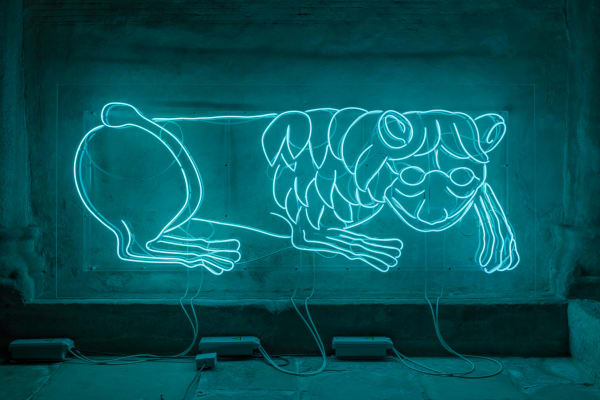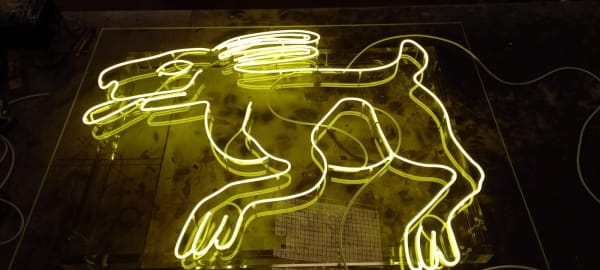MEDIEVAL NEON: BETHAN HUWS
-
介绍
In Medieval Neon, Galerie Thomas Schulte presents two expansive light installations by Bethan Huws in the gallery’s Corner Space and adjacent front room. The works, shown for the first time in Germany, feature animal figures adapted from Romanesque bas-reliefs and formed in thin neon tubes, mounted on transparent panels: one, depicting a group of four monkeys, is suspended from the ceiling, while the other comprises three isolated figures—a hare, a lion, and a monster devouring a human—arranged together on a rack. The simply outlined yet intricate images preserve the aesthetic of their source material, while extending its symbolism and expressivity, transformed and transmitted through the medium of neon.
The works in the exhibition were initially commissioned as part of “Art in the Crypt” at Grossmünster Zürich (2021-2022)—a program that brought contemporary art into the crypt of the Romanesque Protestant church. For her intervention, Huws excerpted figures from the stone-carved bas-reliefs on site, redrawing them on a larger scale in vibrant neon hues.
Referring to the simultaneity of contexts—to the dialogue between past and present—the exhibition’s title, Medieval Neon, may seem a contradiction in terms, but it also describes an unexpected affinity. As Huws has pointed out, the effect of light filtering through a church’s multi-colored stained glass windows is similar to that of the glow of neon—and they share a functional similarity, too, as devices of visual communication. But the use of neon to sculpt images in light also establishes another correspondence: it is not only a concept of medieval neon that is put forth, but also a form of modern bas-relief, as both are situated between two and three dimensionality, playing with perspective and optics.
This hybrid visual culture also exemplifies a duality that is a key point of interest for Huws and one that comes up again and again in the works on view. The artist describes the gestures and expressions of the group of monkeys seen in one work, for example, as being both sweet and nasty. It’s an ambivalence that is enhanced by the color of the light that illuminates the figures: they appear in varying shades of orange, coalescing in vibrant red. A consuming, fiery blaze, its glow both warm and hostile.
The monkeys are seated in two closely huddled pairs in the image. The pair on the left bites into large fruit—perhaps suggestive of the forbidden fruit—while, on the right-hand side, one figure is shown delousing the other. Though both pairs seem to exhibit moments of care and intimacy, the scene appears nonetheless tinged with acts of control, punishment and violence. The hand of one is grasped tightly around the wrist of another in a display of force, for example, and the two figures that bookend the group are tied up by their necks with heavy rope.
As art historian Bernd Nicolai notes in the catalog for the exhibition at Grossmünster Zürich, the female monkey’s body posture as she is being deloused brings another reference into the scene: namely, the Hellenistic sculpture, Crouching Aphrodite *. The image of the nude kneeling at her bath not only adds another layer of dialogue with the past and its visual culture, but also places corresponding associations of idealized beauty and divinity alongside medieval notions of sin.
In their proximity to both humankind and the natural world, monkeys in this context can be seen to represent the base instincts and uncontrollable urges of humans. Huws also underlines that the monkey is associated with imitating behaviors—as pretenders or tricksters—which, she acknowledges, humans are even more adept at. This proximity and resemblance is intensified by the crowdedness of the scene, the positioning of the monkeys—which turn to face each other—and the larger-than-life size of the figures, which, in their crouched-down position, almost serve as a mirror for the viewer. Their peculiar appearance even merges human-like bodies with bestial heads. Their faces, a swirl of frenetic lines, are contorted in grimaces.
In contrast to the side-by-side continuity of the group of monkeys, the three isolated figures displayed in the adjacent space are stratified: laid flat and stacked atop one another on a rack. Here, too, the figures carry layered and at times apparently contradictory meanings. The hare, for example, associated with fertility, rebirth and transformation in Christian iconography, may also embody negatively connotated characteristics, such as instability and double-mindedness. Similarly, the lion may represent the strength and power of Christ or, alternatively, the predatory danger of Satan. The third creature, a monstrous figure devouring a human, is perhaps more straightforward in its depiction of immorality and unfettered appetites. With its wide eyes and open mouth clenched over a fragmented torso as its hands grip either side, the creature has been likened to Francisco Goya’s Saturn Devouring His Son, based on the Greek myth of Cronus. It is a culminating point of violence, in a way, moving beyond threat or suggestion to reach a climax. But the hybrid appearance of the figuremakes it ambiguous once again, a sense that is only amplified by the literal incorporation of man and beast.
It is not possible to view all three figures at once, or even to fully grasp them individually at first, as they overlap each other, illuminating, alternatingly, in different colors—the hare in yellow, the lion in electric blue, and the monster in a bright apple green. Prolonged viewing and changing perspectives are necessary in order to untangle what is being seen. The rhythmic changes in color that occur as the figures illuminate in quick succession, meanwhile, also make the space itself unsteady, placing it, along with the viewer, in flux.
The intensity of light and the hum of transformers extend both works to fill their respective environments, even spilling out from the storefront windows to the street. The display of the group of monkeys, which are hung facing the windows, more closely resembles neon advertising signs, as the arrangement of the three panels on the standing rack seems to make reference to the gallery space by evoking artwork storage. They are ambient, channeling the image- and light-flooded nature of our contemporary world. And while their condensed visual language, inspired by medieval imagery and here further dematerialized, allows for clarity and simplification, it also serves to abstract and conflate. This simultaneity is not only articulated in the images themselves. It is also reflected in the double outlines that appear against their transparent backgrounds, in the plurality that surfaces when their contours cross with the wires behind them—in all of their entangled and layered associations.
Text by Julianne Cordray
* Bernd Nicolai, “Dialogue and Confrontation” in Wars, Societies and Neon, p. 42.
-
作品
-
INQUIRE ABOUT WORKS BY Bethan Huws






